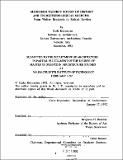| dc.contributor.advisor | Benjamin H. Buchloh. | en_US |
| dc.contributor.author | Keyvanian, Carla L. (Carla Lucia), 1962- | en_US |
| dc.date.accessioned | 2005-08-15T16:14:56Z | |
| dc.date.available | 2005-08-15T16:14:56Z | |
| dc.date.copyright | 1992 | en_US |
| dc.date.issued | 1992 | en_US |
| dc.identifier.uri | http://hdl.handle.net/1721.1/13110 | |
| dc.description | Thesis (M.S.)--Massachusetts Institute of Technology, Dept. of Architecture, 1992. | en_US |
| dc.description | Includes bibliographical references (p. 90-94). | en_US |
| dc.description.abstract | The essay is an analysis Tafuri's theory on historiography;. it traces his methodological sources: the theories, and their mode of reception, that have directly influenced his thought. The period examined starts with Theories and History of Architecture, first published in 1968 and ends with "The Historical 'Project"', the introductory essay of The Sphere and the Labyrinth, published in 1980 The first chapter outlines the intertwining of the two neo-idealist and Marxist components of Tafuri's thought, combined with the early familiarity with the writings of the Nouvelle Critique. Subsequently, it identifies the points that, in Theories and History, represent Tafuri's original contribution to architectural history: the identification of architecture as ideology and the consequent demystifying role that the historian must play; consequently, the formulation of the specific notions that will serve as the instruments for this task of the historian; the identity of history and criticism; the complete separation of the design process from the 'reading' process (Le. history writing) of a building; the logical consequence of this: the 'futility' of history and theory in design; and, finally, the obsoleteness of the mode of criticism termed "operative criticism". The second chapter tackles the problem posed by the contradictory coexistence, in Tafuri's later writings, of Marxist and neo-avant-garde positions. It analyzes in detail what neo-avant-garde ideas were, what they implied and what theoretical and methodological purposes they served. The analysis centers on the strong impact of Foucault's theories on Tafuri, and his equally strong criticism of them. Most importantly, however, it outlines the profound impact of Walter Benjamin's notion of history, particularly as exposed in "The Theses on the Philosophy of History", on Tafuri. In the last chapter, are drawn some partial conclusions on the epistemological implications of Tafuri's theory. | en_US |
| dc.description.statementofresponsibility | by Carla Keyvanian. | en_US |
| dc.format.extent | 94 p. | en_US |
| dc.format.extent | 6834267 bytes | |
| dc.format.extent | 6834022 bytes | |
| dc.format.mimetype | application/pdf | |
| dc.format.mimetype | application/pdf | |
| dc.language.iso | eng | en_US |
| dc.publisher | Massachusetts Institute of Technology | en_US |
| dc.rights | M.I.T. theses are protected by copyright. They may be viewed from this source for any purpose, but reproduction or distribution in any format is prohibited without written permission. See provided URL for inquiries about permission. | en_US |
| dc.rights.uri | http://dspace.mit.edu/handle/1721.1/7582 | |
| dc.subject | Architecture | en_US |
| dc.title | Manfredo Tafuri's notion of history and its methodological sources : from Walter Benjamin to Roland Barthes | en_US |
| dc.type | Thesis | en_US |
| dc.description.degree | M.S. | en_US |
| dc.contributor.department | Massachusetts Institute of Technology. Department of Architecture | |
| dc.identifier.oclc | 26387004 | en_US |
